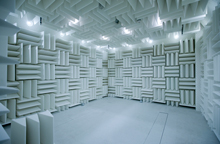An acoustic testing room and mesurement (anechoic or semi-anechoic, including: the experimental chamber of an aero-acoustic wind tunnel) is a space in which one tries, for the purpose of research and development in acoustics (R&D), to create the conditions of an acoustic field being free (sometimes: on a reflecting plane) i.e. liberated from the limits imposed by the presence of walls.The acoustic performance of such test facilities is therefore absolutely crucial, generally taking precedence over any other consideration in the context of related projects; ITS masters all aspects of the performance of acoustic testing and measurement rooms.
The on site-verification of the performance of acoustic testing and measurement rooms (and their qualifications) can be conducted according to standard NF EN ISO 3745 Acoustics - Determination of sound power levels of noise sources - Precision methods for anechoic and semi anechoic rooms. This document is often referred to in technical specifications relating to such equipment.

ITS masters all aspects of the performance of acoustic testing and measurement rooms. |
Performance of an acoustic testing and measurement room in terms of anechoicity
The performance of an acoustic testing and measurement room (anechoic or semi-anechoic rooms, including: aero-acoustic wind tunnels), in terms of cut-off frequency (frequency above which the absorption coefficient at normal incidence of the absorbing element of the partitions is greater than 99% for walls, roof and where applicable - for anechoic rooms- floorl) is characterized by a measurement of a lining sample in a plane waves impedance tube. By extension (in fact: so shortened), the cutoff frequency is often referring to (in practice) the frequency above which the conditions inside the test room are those of a free (acoustic) field (in the case of a semi anechoic room: with a reflective floor), and sometimes: taking into account the tolerances set by the standard NF EN ISO 3745.
As an order of magnitude, a cutoff frequency below 50 Hz can be achieved with an absorbing lining with a careful design and with a careful implementation.
The performance of an acoustic testing and measurement room (anechoic or semi-anechoic rooms, including: aero-acoustic wind tunnels), in terms of quality of the free field is very frequency dependent and is primarily related to the performance of the absorbing lining (for walls, roof and where appropriate - for anechoic chambers - floor) (characterized by their absorption coefficient at normal incidence).
This performance can be expressed in terms of deviation of measured sound pressure levels with respect to the theoretical levels obtained using the law of the inverse square of the distance (i.e. in terms of deviation from the spatial sound decay in a free field) by octave or 1/3 octave bands at specified locations.
For orders of magnitude deviations of measured sound pressure levels with respect to the theoretical levels obtained using the law of the inverse square of the distance up to 1.5 dB at frequencies below 630 Hz, up to 1.0 dB at frequencies between 800 and 5000 Hz, up to 1.5 dB at frequencies above 6300 Hz can be obtained in the case of testing stations in accordance with standard NF EN ISO 3745.
An additional aspect of the performance of an acoustic testing and measurement room which may be of interest for some users of such equipment (generally: engineers and researchers in acoustics) is the convertibility: anechoic/semi-anechoic . The difference is only in the behavior of the floor: absorbing/reflecting sound; on the one hand obtaining for both configurations acoustic characteristics at the best level and on the other hand conversion methods combining safety, ease and speed must be the object of all the care in terms of design and construction to obtain a room constituting the ultimate.
In relation to the predictioon of the performance of acoustic testing and measurement rooms in terms of cut-off frequency and quality of the free acoustic field, the simulation of the sound absorption coefficient (in normal or random incidence) of multilayered structures (e.g. combining mineral or polyester wools, foams, metal plates) can be performed with the SILDIS® software, developped and edited by ITS.
Performance of an acoustic testing and measurement room in terms of sound insulation
The performance of an acoustic testing and measurement room (anechoic or semi-anechoic rooms, including: aero-acoustic wind tunnels), in terms of sound insulation is very frequency dependent and is primarily related to airborne sound attenuation of the envelope (characterized by its sound reduction index) and also the effectiveness of the vibration control device (characterized by its filtration rate).
This performance can be expressed in terms of background nosie, i.e. in terms of A-weighted overall sound pressure levels or in terms of sound pressure levels in octave bands inside the test room.
For orders of magnitude, inside the testing room, A-weighted overall sound pressure levels of 10 dBA or less or sound pressure levels in octave bands of 0 dB or less can be obtained in the case of some performing testing facilties (always with a special construction).To obtain such results, it is necessary to build an envelope limiting the transmission of airborne noise; its elements (floor, roof, walls including doors and devices for limiting the propagation of noise at the level of openings e.g. silencers, caulking) must often have an exceptional average sound reduction index; even when using high-performance acoustic structures (thick concrete, metal panels with reinforced acoustic insulation), it is often useful to design and build double-shell edifices (according to the so-called "box-in-box" principle).
In relation to the prediction of the performance of acoustic testing and measurement rooms in terms of airborne sound insulation, the sound reduction index (in diffuse field) of multilayered structures (e.g. combining mineral or polyester wool, foams, metal plates or made of plaster and masonry elements) can be performed with the SILDIS® simulation software, developed and published by ITS.